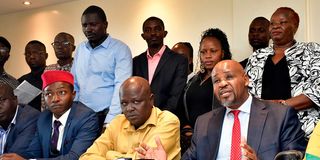Kuppet defends new constitution amendments amid backlash

Kenya Union of Post Primary Education Teachers (Kuppet) Deputy Secretary General Moses Nthurima (right) gestures during a media briefing at Hill Park Hotel on March 25, 2025. With him is Junior Secondary School (JSS) Teachers National Spokesperson Omari Omari (left) and Kuppet National Vice Chairman Julius Korir.
The Kenya Union of Post Primary Education Teachers (Kuppet) has defended its newly amended Constitution, emphasising that the changes were a product of extensive consultations and democratic processes.
This was after Kuppet’s proposed constitutional amendments sparked internal strife, with members opposing the removal of the age limit for national office holders and an increase in nomination fees. Members said these changes were made without proper consultation. Some members had even taken the fight to court, challenging the amendments.
However, the Registrar of Trade Unions later rejected the proposals, citing procedural and substantive issues, adding fuel to the union’s growing divisions.
Speaking after a National Executive Board meeting, Acting Secretary-General Moses Nthurima said the amendments were designed to improve representation, promote diversity, and ensure the union reflects the evolving needs of its members, which he said would include women, youth, and teachers with disabilities.
While acknowledging some dissent among members, he maintained that the amendments went through a legal and democratic process, culminating in approval by the Registrar’s Plenary Meeting.
“People who are opposed to the Constitution, they have a reason to do so, but the majority always takes the day. So, of course, the Constitution has been registered because we started by engaging the teachers on the ground, and the teachers gave their input. Then we engaged the leadership; they gave their input. And once we did that, we engaged also the organs of the Union, and they gave their input. And finally we went to the ADC, where this Constitution was voted for, and it went through,” he said.
Further, Mr Nthurima said that the mandatory retirement age for union officials remains 65 years, noting that the flexibility in wording was introduced to allow union leaders, particularly those affected by dismissals from teaching positions due to union duties, to continue serving without risking their careers.
“The retirement age for union officials is 65 years — it’s not eternity, as some reports suggest. It is set this way because of the opportunity cost. Many officials are dismissed from their teaching positions due to union duties, and to address this, we give them more time to serve so they can continue contributing to the union and creating jobs. Some are seconded to the union and miss out on promotions, so this structure helps compensate for that. We want to be clear: the mandatory retirement age for union officials is 65 years — not forever. There are many other pressing issues that need our focus,” he said.
On the junior school teachers, Mr Nthurima emphasised that JSS teachers rightfully belong to Kuppet by virtue of their appointment as post-primary teachers, aligning with Kenya’s constitutional categorisation of schools into pre-primary, primary, and secondary levels.
He dismissed claims that JSS teachers were forced to join the union, clarifying that their inclusion was automatic and legally recognised.
“There’s a widespread misconception that JSS teachers have been forced to join Kuppet. I want to be clear — JSS teachers belong to Kuppet because, by appointment, they are classified as post-primary teachers. The Constitution of Kenya recognises three categories of schools: pre-primary, primary, and secondary. Since JSS falls under secondary education, whether these teachers are based in primary or secondary schools, they are considered part of the post-primary teaching category,” he explained.
The proposed changes in the Kuppet constitution include an expansion of the union’s executive offices from 10 to 14 officials, introducing positions like Assistant National Secretary Gender, representing young teachers and those from marginalised regions. Additionally, a new role for Junior Secondary School representatives was established to address concerns arising from the new curriculum structure.
The new Constitution also introduces Regional Councils to address geographical representation gaps; increases the number of Trustees from four to nine to ensure equitable oversight of the union’s assets; and implements a pro-rata delegate system to ensure no branch is underrepresented.
Four new national-level leadership positions have been created, three of which will be filled by women, while the remaining one is reserved for Junior Secondary School representation — ensuring young teachers have a voice at the top level.
To address past inequalities in delegate numbers, the new system allocates 14 delegates per branch, with an additional delegate added for every 100 members beyond the first 300. This ensures larger branches receive fairer representation, correcting previous imbalances where smaller branches like Isiolo (300 members) sent the same number of delegates as larger branches like Nyeri (6,000 members).
“The revised Constitution ensures representation for people living with disabilities and adheres to the two-thirds gender rule, promoting equality in leadership and decision-making processes,” he said.


